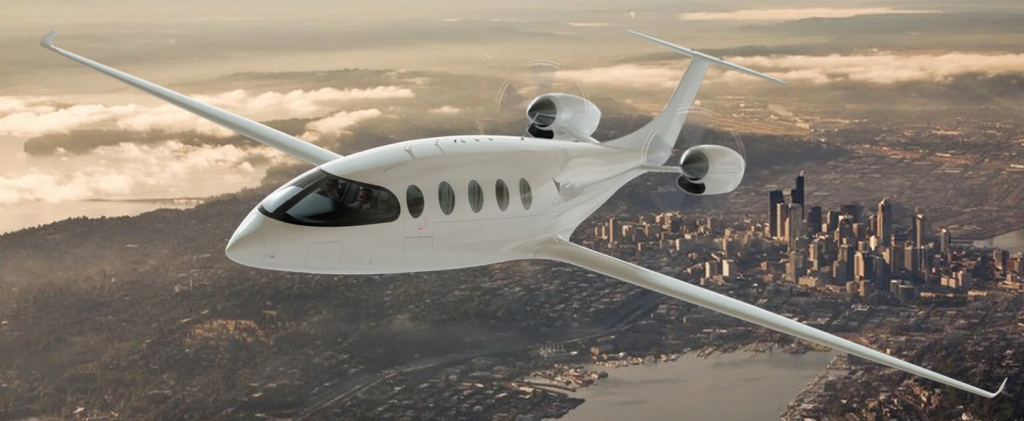Washington D.C. – Science Fiction often depicts the year 2000 as a year of flying cars, artificial intelligence, and autonomous computers. Although it may seem like we are a long way from realizing the Jetsons vision of 2062, recent innovations in the U.S. aerospace industry indicate that the future may be closer than most would expect.
“It becomes clear that within the next ten years aerospace is going to evolve,” U.S. Rep. Garret Graves (LA-06) said at a Subcommittee Hearing on “Leading Edge: Innovation in U.S. Aerospace” chaired by U.S. Rep. Rick Larsen (WA-02).
Aerospace innovators discussed a series of projects at April 27th’s Aviation Subcommittee hearing that included electric aircraft, supersonic aircraft, and unmanned aircraft systems that could be certified as early as next year.
“This is a long-overdue discussion to explore promising opportunities for U.S. aerospace, including emerging airspace entrants and new aviation technologies with potential societal, safety, and environmental benefits,” Representative Larsen, Aviation Subcommittee chair, opened.
“Fostering innovation is one of my top priorities as Chair because it will help bolster U.S. jobs and grow the nation’s leadership in the aerospace industry.”
Advanced Air Mobility/Electric Aircraft

Los Angeles Mayor Eric Garcetti presented their city’s approach to safe, equitable, and zero-emission mobility options which include Advanced Air Mobility (AAM) options.
The Federal Aviation Administration (FAA) defines the AAM as a “safe and efficient aviation transportation system that will use a highly automated aircraft to transport people and goods at lower altitudes.”
“Once only seen in science fiction or dropping Judy and Elroy off at school, ‘flying cars’ and ‘air taxis’ will soon be a reality with over 70 advanced air mobility (AAM) concepts in development,” Larsen said.

According to Mayor Garcetti, these “flying cars,” or Urban Air Mobility (UAM), add a third dimension for moving people and are capable of carrying one to five passengers, flying at speeds of 150 to 200 miles per hour over a range of 60 to 200 miles.
“With these capabilities, UAM has the potential to add a new option for connectivity and accessibility throughout the Southern California region, particularly for difficult commutes where non-auto options are lacking,” Garcetti said.
The city of Los Angeles has already begun work on these projects including public-private partnerships to delineate clear lines of responsibility, accountability, and information exchanges, as well as planning and design efforts that integrate communities and infrastructure.

“I think that over time the use of advanced air mobility can play a part in reducing decongestion with the use of air taxis. Our technology has advanced a long way since we used to watch the Jetsons, and now it’s actually a reality, and a lot of companies are investing a lot to make air mobility a reality as well,” Larsen told the Lynnwood Times concerning how air mobility options could reduce traffic congestion in Snohomish County sometime in the future.
Although air taxis are projected to become a reality by 2050, Larsen believes it could be much sooner.
While Los Angeles explores urban mobility, Everett’s magniX looks to a more sustainable and energy-efficient aircraft that has already undergone test flight and aims to be certified by 2022.
The first all-electric, commercially-focused aircraft, the five-passenger eBeaver, took flight on December 10, 2019, in Vancouver, British Columbia, and has been flying ever since, collecting data, testing performance, and measuring noise, according to magniX CEO Roei Ganzarski.
A few months after the eBeaver’s flight, in Moses Lake, WA, magniX started flying the world’s largest all-electric commercially-focused plane – the magnified 9- to 12- passenger Cessna 208B Grand Caravan, now known as the eCaravan.
“With this aircraft flying at 8,000 feet, new heights were literally and figuratively achieved in terms of electric aircraft power and performance,” Ganzarski said. “Both of our aircraft flew without creating emissions. Not one ounce of CO2 was emitted from these flights.”
Later this year, the nine-passenger, all-electric Aviation Alice, the first aircraft to be designed from the ground up as an electric commuter, will be taking flight for the first time in Arlington, WA. According to Ganzarski, this will be a “monumental watershed moment” for the aerospace industry and is expected to fly without any emissions.

“While this may sound like an unrealistic utopia, for the most part, the technology and infrastructure to provide such an aerospace environment is being developed, flight-proven, and on the path to FAA certification today. It is called the ‘Electric Age of Aviation.’ It will happen. The question is, will the United States lead or lag?” Ganzarski said.

Ganzarski noted that the United States has always been a leader on the world stage, particularly in aviation dating back to the Wright Brothers, but is recently “falling short” behind countries like Sweden and Norway who recently pledged that all domestic flights will be emission-free by 2030 and 2040, respectively.
In this future aviation system, average Americans, including in more rural areas, should be able to drive no more than 15 minutes to their nearest airport, arrive only 15 minutes ahead of their flight, walk onboard without hassles or waiting in lines since the airport is smaller, fly for up to a few hours, land, and arrive at their destination in another 15 minutes because their smaller arrival airport is closer to their final destination.
“The United States must act in unity and continue to move rapidly, aggressively, intentionally and with focus, if we want to lead this global electric aviation revolution that is happening,” Ganzarski said.
Unmanned Aircraft Systems
The FAA projects the use of drones will reach over 2 million units by 2024, combining both private and commercial use. Drones are used today to perform critical infrastructure inspections, assist in recovery efforts following natural disasters, and deliver critical medical supplies during the pandemic.

James L. Grimsley of the Choctaw Nation of Oklahoma, the first and only tribal government to be selected by the U.S. Department of Transportation to participate in the Drone Integration Pilot Program, discussed the Choctaw Nation’s ongoing project, under the FAA’s BEYOND program, to test advanced drone operations and analyze the impact of this technology on tribal and rural communities. These include rural and remote infrastructure inspection, medical response in rural areas, farming and ranching occupation hazards, impacts on STEM and Workforce Preparation, and enhancing weather research and forecasting.
A Presidential Memorandum by President Donald J. Trump, established the Unmanned Aircraft System Integration Pilot Program (IPP) in October 2017. FAAs BEYOND program is a Memoranda of Agreement with 10 local, state, and tribal governments to conduct advanced UAS operations to advance safe and secure integration under this IPP.
In December 2020, the FAA issued two long-awaited UAS final rules, which took effect in April – one requiring the remote identification (ID) of UAS and another permitting more routine UAS operations over people under certain conditions.

Speaking on the importance of the drone industry was Adam Bry, Chief Executive of Skydio, the largest U.S. drone manufacturer by volume and a world leader in autonomous flight.
According to Bry, autonomous aviation severely slashes away at carbon emissions compared to traditional methods. Helicopters, for example, burn more fuel and emit far more CO2 emissions than cars do over the same distance. Additionally, under-bridge inspections achieve around 5 mpg.
“Drones shatter this paradigm. If a state with 14,000 bridges could inspect 5,000 of them using drones, the carbon savings would be equivalent to removing 1,000 cars from the road,” Bry said.

North Carolina Department of Transportation (DOT), a partner and customer of Skydio, has become a national leader in the employment of drone technology for bridge inspection and other purposes. Eric Boyette, North Carolina’s Secretary of Transportation, has stated that “drones are a fantastic new tool for our Bridge Inspection Units.”
The American Society of Mechanical Engineers has observed that “drones can perform hazardous inspections and maintenance scans much more quickly and with greater ease, lessening the perils on the American worker.”
About 70% of the drone market accounts for foreign companies, largely in China. The Chinese Government has the legal ability to demand data from Chinese companies operating anywhere in the world, according to a report by CNBC.
In addition to offering a greener solution to inspections, supply delivery, and economic benefits, Bry also noted that maintaining a viable domestic drone manufacturing base could aid in cybersecurity.
Last month NASA published a report concerning data and reasoning fabrics for what they call a “smart city” which envisions a digital “marketplace” where providers such as weather services, mapping and surveying firms, air traffic management, can offer their data to aircraft operators via digital agreements using drone technology.
Supersonic Aircraft
Recent advancements in propulsion technology, materials, and domestic manufacturing have also made supersonic flights more of a reality. Traveling faster than the speed of sound, these flights are projected to significantly reduce trans-oceanic travel times and open new gateways to support international commerce.

However, challenges persist to full deployment of supersonic flight, most notably, the lack of internationally recognized certification, noise, or emission standards for supersonic aircraft.
In response to the 2018 FAA reauthorization law, the FAA recently issued a final rule to help facilitate supersonic flight testing and the safe development of such aircraft.
Boom Supersonic has already begun flight tests for their Overture supersonic aircraft that would enable oceanic flight between New York and London within three and half hours.

“Until the middle of the twentieth century, people could expect continued innovation in travel speeds. Railroads, steamships, piston-powered airliners, and jets each represented a significant improvement in how we got around. But in 2021, we’re flying no faster than we were in 1960,” Blake Scholl, founder and CEO of Boom Supersonic said. “With Overture, three-day business trips could be done in just one day—you could attend meetings across an ocean and be home in time to tuck your children into bed.”
Due to noise standards, Boom Supersonic is only working on commercial flights over water but hopes to someday expand to continental travel as noise solutions are met. The company hopes to launch the Overture for commercial travel by 2026.
“Traditional wisdom says that supersonic flights are expensive, uncomfortable, noisy, and unsustainable. Thanks to key breakthroughs at Boom and innovations across the industry, supersonic flight can now be not just faster but also more comfortable, more affordable, and sustainable,” Scholl said.
Representative Larsen told the Lynnwood Times there are currently companies in Washington State that are partnering with supersonic aircraft developers to establish noise standards in preparation for future continental supersonic air travel.
Larsen on preparing District 2 for the future of Aerospace

Representative Larsen believes there are many steps Washington State’s congressional district two has to make to prepare for these innovations in aerospace, but the process is underway.
“A lot of what needs to be done is to ensure that we’re educating the next generation of aerospace workers, aerospace engineers, scientists, and the support network that’s necessary in part of developing and maintaining these new innovations,” Larsen told the Lynnwood Times.
Concerning safety, Larsen has spent a lot of time on the aviation subcommittee holding oversight hearings that resulted in the development and passage of a major aircraft certification reform. That certification reform bill became law at the end of last year and the FAA has been implementing pieces and parts of it that he hopes will return the FAA to the gold standard of aircraft safety and certification.
“We think that the United States has set the standard for safety certification and we need to continue to live up to that,” Larsen told the Lynnwood Times.
“I think in the Northwest we have to think about aerospace beyond Boeing and including Boeing because that’s where the opportunity is and if we’re going to maintain our title as the aerospace capital of the world we have to think about all of aerospace and not just a piece of it.”
Author: Kienan Briscoe










4 Responses